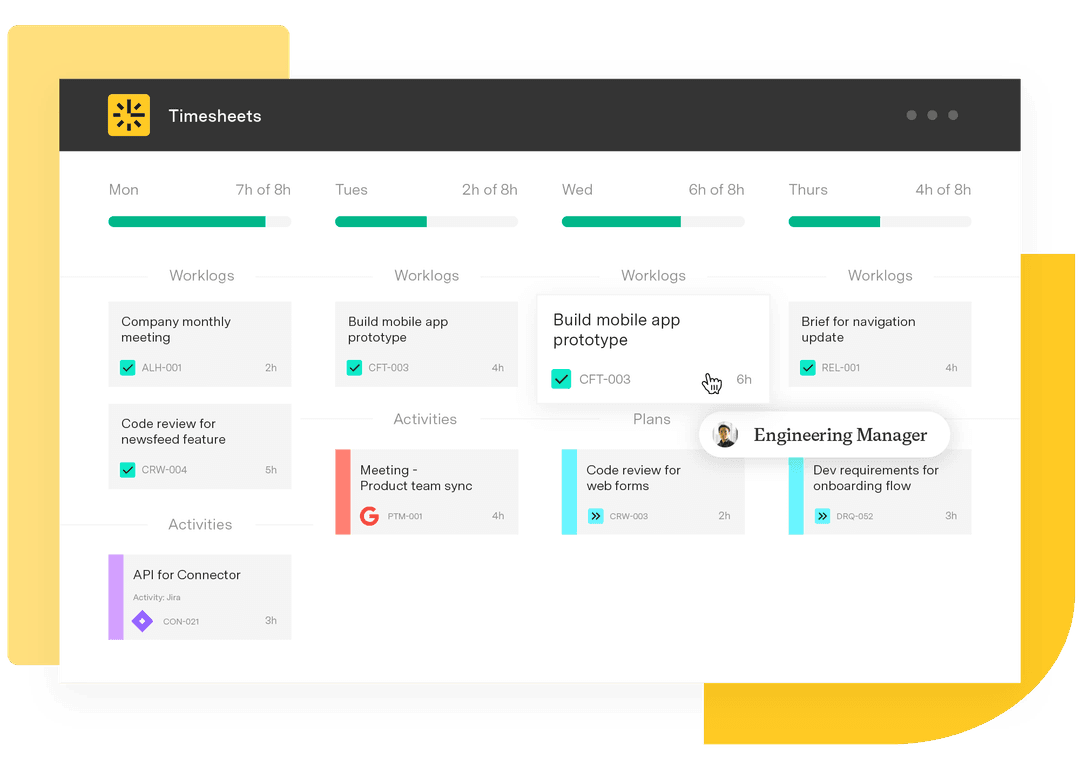How performance review templates improve employee evaluations
Tempo Team
Employee performance reviews are one of a manager’s most valuable tools. They provide an opportunity to assess employee growth and align individual contributions with company goals. They also deliver constructive feedback in an accessible format that helps team members understand and live up to expectations.
A performance review template establishes a framework that makes feedback specific and actionable. Managers save time while comprehensively addressing workers’ accomplishments and shortcomings. Best of all, performance review templates facilitate better development conversations and more effective performance management.
This guide explains how performance review templates improve the employee evaluation process. It also provides examples of templates that serve various development goals.
What is a performance review?
An employee performance review evaluates each team member’s job performance during a specific period – often quarterly, biannually, or annually. Managers assess how well employees met their responsibilities and contributed to their teams. The review helps both parties understand the employee’s strengths and coordinate expectations between the team and the organization.
A performance review should give team members actionable, individualized feedback and help them understand how their work connects to broader company goals. Managers can use these conversations to guide development and flag issues early. Employees get a chance to reflect on feedback, conduct a self-assessment, and set ambitious professional objectives.
Types of performance review templates and how to use them
The ideal performance review template depends on your goals and the feedback you want to gather. A template should provide structure without limiting insight, letting you tailor feedback while maintaining a consistent employee review process.
Here are six widely used employee review templates, each with distinct advantages:
1. General performance review template
This is the most versatile option. It evaluates job knowledge, communication, problem-solving, teamwork, and reliability. Managers rate employees in each category before the performance appraisal meeting and provide written feedback.
Use this template when you need a universal format across teams or departments. It works well for annual performance reviews and helps benchmark performance over time.
2. Self-evaluation template
A self-assessment template asks employees to evaluate their performance before the manager’s review. This employee evaluation form includes prompts like: “What accomplishments are you most proud of?” and “What challenges did you face this quarter?”
Self-assessments encourage reflection and ownership. They also reveal how closely an employee’s self-perception matches the manager’s performance appraisal, which can spark constructive conversations.
3. 360-degree review template
In addition to the manager’s input, this format collects performance feedback examples from peers, direct reports, and sometimes external collaborators. It offers a well-rounded appraisal of how employees operate across different working relationships.
Use this template to report on performance for roles that rely heavily on collaboration.
4. OKR-based review template
This template directly links an employee’s performance to their objectives and key results (OKRs). It evaluates employees on how well they met specific goals and contributed to company outcomes. OKR-based reviews are especially effective in agile environments
5. Project-based review template
This format evaluates employee performance per project. It might include criteria like timeline adherence, contribution to deliverables, and post-project analysis. Project-based templates are helpful for contractors or roles that don’t follow a consistent workflow.
6. Skill and competency-based review template
This employee review template divides performance based on core competencies required for the role, such as technical ability or decision-making skills. Ratings are tied to defined benchmarks to make the process objective.
Use this template to track professional growth and compare employees with similar responsibilities.
Benefits of using a performance evaluation template
Employee performance review templates bring structure and clarity to an otherwise subjective and inconsistent process. Here are six benefits of using templates for performance appraisal across your organization:
Consistency between teams and reviewers
Reviews are easier to compare across departments and reporting lines when everyone uses the same format. Templates eliminate personal bias in how performance is framed and judged, helping leaders spot patterns, reward reasonably, and ensure consistent standards from one manager to the next.
Clearer expectations for employees
Templates define success. When employees know how they’ll be evaluated, they feel less confusion and anxiety regarding reviews. Team members can focus their efforts on organizational goals.
Faster, more efficient reviews
Templates reduce prep time for managers and HR teams. A ready-made structure allows them to focus on meaningful feedback instead of reinventing the wheel every review cycle.
Stronger, more actionable feedback
Structured templates prompt reviewers to give constructive feedback across various performance areas, not just their top-of-mind impressions. This promotes more balanced reviews with clearer examples of strengths and areas for improvement. Employee review templates also reduce the risk of recency bias – when recent performance dominates the review.
Easier tracking of development over time
Templates create a paper trail that helps leaders monitor progress across review cycles. You can see how performance evolved and which goals were met. This is especially useful when considering promotions or resolving performance issues.
Better alignment with organizational goals
Templates connect individual performance to business objectives and encourage accountability at every level. Teams can easily understand how their work contributes to company strategy.
Align individual growth with strategic goals using Tempo
Performance reviews are an excellent way to connect individual performance with team goals and company strategy, but they aren’t the only way. Data analysis illustrates how people spend their time and how their work contributes to organizational objectives. This is where Tempo’s tools come in handy.
Timesheets shows managers how employees allocate their time across tasks and projects. This data is invaluable during performance reviews. Did they prioritize work effectively? Were they pulled into unrelated tasks that impacted progress? This context supports accurate employee evaluations and helps leaders identify workload issues early.
You can also use Timesheets data to compare effort across individuals and teams and adjust assignments in future cycles. It shows how daily activity contributes to deliverables and performance goals, helping you assess whether someone’s time investment supports company priorities.
Custom Charts allows you to visualize real-time performance and progress against key metrics. You can build tailored dashboards to track indicators like issue resolution time and project velocity. During employee reviews, these charts provide data to support or challenge assumptions about performance.
They also help teams identify where efforts are aligned – or misaligned – with strategic goals. For example, if a team’s velocity increases but key objectives remain unmet, you can use Custom Charts to analyze the work breakdown. This shows whether the team focused on the right tasks and whether individual efforts contributed meaningfully to outcomes.
Together, Timesheets and Custom Charts help performance reviews dig deeper than general impressions.













































